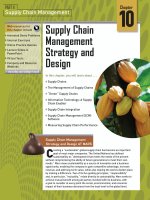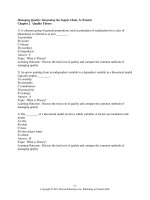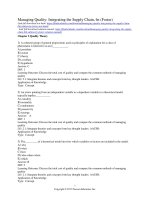Lecture Operations management: Creating value along the supply chain (Canadian edition) - Chapter 3S
Bạn đang xem bản rút gọn của tài liệu. Xem và tải ngay bản đầy đủ của tài liệu tại đây (243.98 KB, 14 trang )
OPERATIONS MANAGEMENT:
Creating Value Along the Supply Chain,
Canadian Edition
Robert S. Russell, Bernard W. Taylor III, Ignacio Castillo, Navneet Vidyarthi
CHAPTER 3 SUPPLEMENT
Acceptance Sampling
Supplement 3-1
Lecture Outline
Single-Sample Attribute Plan
Operating Characteristic Curve
Developing a Sampling Plan with Excel
Average Outgoing Quality
Double - and Multiple-Sampling Plans
Supplement 3-2
Acceptance Sampling
Accepting or rejecting a production lot based on
the number of defects in a sample
Not consistent with TQM or Zero Defects
philosophy
producer and customer agree on the number of
acceptable defects
a means of identifying not preventing poor quality
percent of defective parts versus PPM
Sampling plan
provides guidelines for accepting a lot
Supplement 3-3
Single–Sample Attribute Plan
•
Single sampling plan
•
•
•
•
•
N = lot size
n = sample size (random)
c = acceptance number
d = number of defective items in sample
If d ≤c, accept lot; else reject
Supplement 3-4
Producer’s and Consumer’s Risk
AQL or acceptable quality level
proportion of defects consumer will accept in given lot
or producer’s risk
probability of rejecting a good lot
LTPD or lot tolerance percent defective
limit on the number of defectives the customer will accept
β or consumer’s risk
probability of accepting a bad lot
Supplement 3-5
Producer’s and Consumer’s Risk
Good Lot
Reject
No Error
Type I Error
Producer’ Risk
Bad Lot
Accept
Type II Error
Consumer’s Risk
No Error
Sampling Errors
Supplement 3-6
Operating Characteristic (OC) Curve
Shows probability of accepting lots of different
quality levels with a specific sampling plan
Assists management to discriminate between good
and bad lots
Exact shape and location of the curve is defined by
the sample size (n) and acceptance level (c) for the
sampling plan
Supplement 3-7
OC Curve
Supplement 3-8
Developing a Sampling Plan
with OM Tools
ABC Company produces mugs in lots of 10,000.
Quality contracts require producer’s risk of 0.05 with
an AQL of 1% defective and a consumer’s risk of
0.10 with a LTPD of 5% defective. What size
sample and what acceptance number should ABC
use to achieve performance measures called for in
the sampling plan?
N = 10,000
α = 0.05
β = 0.10
AQL = 1%
LTPD = 5%
n=?
C=?
Supplement 3-9
Average Outgoing Quality (AOQ)
Expected number of defective items that will pass
on to customer with a sampling plan
Average outgoing quality limit (AOQL)
maximum point on the curve
worst level of outgoing quality
Supplement 3-10
AOQ Curve
Supplement 3-11
Double-Sampling Plans
Take small initial sample
If # defective ≤ lower limit, accept
If # defective > upper limit, reject
If # defective between limits, take second sample
Accept or reject based on 2 samples
Less costly than single-sampling plans
Supplement 3-12
Multiple-Sampling Plans
Uses smaller sample sizes
Take initial sample
If # defective ≤ lower limit, accept
If # defective > upper limit, reject
If # defective between limits, resample
Continue sampling until accept or reject lot based
on all sample data
Supplement 3-13
COPYRIGHT
Copyright © 2014 John Wiley & Sons Canada, Ltd.
All rights reserved. Reproduction or translation of
this work beyond that permitted by Access Copyright
(The Canadian Copyright Licensing Agency) is
unlawful. Requests for further information should be
addressed to the Permissions Department, John
Wiley & Sons Canada, Ltd. The purchaser may make
back-up copies for his or her own use only and not
for distribution or resale. The author and the
publisher assume no responsibility for errors,
omissions, or damages caused by the use of these
programs or from the use of the information
contained herein.









